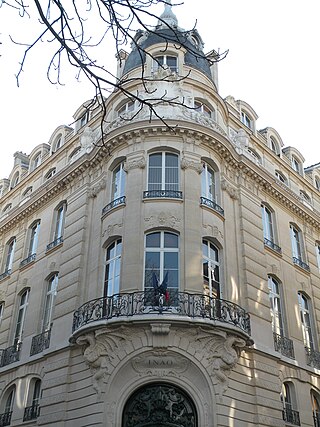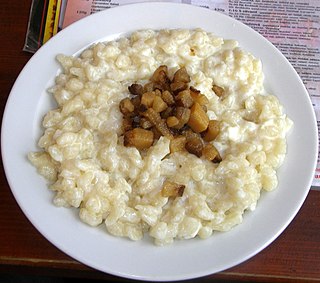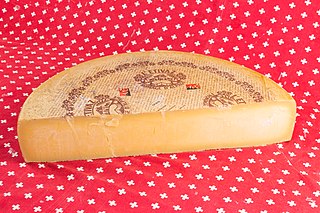
Roquefort is a sheep milk blue cheese from southern France. Though similar cheeses are produced elsewhere, EU law dictates that only those cheeses aged in the natural Combalou caves of Roquefort-sur-Soulzon may bear the name Roquefort, as it is a recognised geographical indication, and has a protected designation of origin.

Three European Union schemes of geographical indications and traditional specialties, known as protected designation of origin (PDO), protected geographical indication (PGI), and traditional speciality guaranteed (TSG), promote and protect names of agricultural products and foodstuffs. Products registered under one of the three schemes may be marked with the logo for that scheme to help identify those products. The schemes are based on the legal framework provided by the EU Regulation No 1151/2012 of the European Parliament and of the Council of 21 November 2012 on quality schemes for agricultural products and foodstuffs. This regulation applies within the EU as well as in Northern Ireland. Protection of the registered products is gradually expanded internationally via bilateral agreements between the EU and non-EU countries. It ensures that only products genuinely originating in that region are allowed to be identified as such in commerce. The legislation first came into force in 1992. The purpose of the law is to protect the reputation of the regional foods, promote rural and agricultural activity, help producers obtain a premium price for their authentic products, and eliminate the unfair competition and misleading of consumers by non-genuine products, which may be of inferior quality or of different flavour. Critics argue that many of the names, sought for protection by the EU, have become commonplace in trade and should not be protected.

The following four classifications of wine constitute the Italian system of labelling and legally protecting Italian wine:

Emmental, Emmentaler, or Emmenthal is a yellow, medium-hard cheese that originated in the Emme valley, Switzerland. It is classified as a Swiss-type cheese.

In France, the appellation d'origine contrôlée(AOC) is a label that identifies an agricultural product whose stages of production and processing are carried out in a defined geographical area – the terroir – and using recognized and traditional know-how. The specificity of an AOC product is determined by the combination of a physical and biological environment with established production techniques transmitted within a human community. Together, these give the product its distinctive qualities.

A geographical indication (GI) is a name or sign used on products which corresponds to a specific geographical location or origin. The use of a geographical indication, as an indication of the product's source, is intended as a certification that the product possesses certain qualities, is made according to traditional methods, or enjoys a good reputation due to its geographical origin.

The Institut national de l'origine et de la qualité (INAO) is the French organization charged with regulating French agricultural products with protected designation of origin (PDOs). Controlled by the French government, it forms part of the Ministry of Agriculture. The organization was co-founded by Châteauneuf-du-Pape producer Baron Pierre Le Roy.

Ossau-Iraty is an Occitan-Basque cheese made from sheep's milk.
Prodotto agroalimentare tradizionale (PAT) is an official approval for traditional Italian regional food products similar to the protected geographical status of the European Union. A list of approved products is published by the Ministry of Agricultural, Food and Forestry Policies. It lists only products that do not qualify for pan-European approval, and as such PAT is only applicable within Italy.

Damassine is a clear, fruit spirit, distilled from the red damson plum, produced exclusively in the Swiss Republic and Canton of Jura following appellation d'origine protégée (AOP) guidelines that require specific sourcing and production practices. Damassine is also considered an eau de vie, more specifically an eau de vie de prunes, and is commonly referred to as a fruit brandy contrary to the regulation defining it as a fruit spirit.
Strada dell'olio is a kind of gastronomical route in Italy that crosses a territory rich of traditional products, PDOs and PGIs, DOCs and DOCGs in Italy. It is sometimes linked to an enological tour.
Imokilly Regato is a cows' milk hard cheese made in Mogeely, County Cork, Ireland.

Traditional foods are foods and dishes that are passed on through generations or which have been consumed for many generations. Traditional foods and dishes are traditional in nature, and may have a historic precedent in a national dish, regional cuisine or local cuisine. Traditional foods and beverages may be produced as homemade, by restaurants and small manufacturers, and by large food processing plant facilities.

In Switzerland, the appellation d'origine protégée is a geographical indication protecting the origin and the quality of traditional food products other than wines.
The denominazione comunale d'origine (De.CO) or denominazione comunale (De.Co.) is an Italian recognition established and granted by the municipal administration in order to protect and enhance a typical product, a traditional recipe, an agri-food business or a craft product in close correlation with the territory and its community, without any overlap with the designations of origin in force. The municipal designation of origin, unlike designations such as PDO, PGI and TSG, is not a quality indication, but a certificate of typicality.










